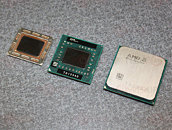- Joined
- Oct 9, 2007
- Messages
- 47,670 (7.43/day)
- Location
- Dublin, Ireland
| System Name | RBMK-1000 |
|---|---|
| Processor | AMD Ryzen 7 5700G |
| Motherboard | Gigabyte B550 AORUS Elite V2 |
| Cooling | DeepCool Gammax L240 V2 |
| Memory | 2x 16GB DDR4-3200 |
| Video Card(s) | Galax RTX 4070 Ti EX |
| Storage | Samsung 990 1TB |
| Display(s) | BenQ 1440p 60 Hz 27-inch |
| Case | Corsair Carbide 100R |
| Audio Device(s) | ASUS SupremeFX S1220A |
| Power Supply | Cooler Master MWE Gold 650W |
| Mouse | ASUS ROG Strix Impact |
| Keyboard | Gamdias Hermes E2 |
| Software | Windows 11 Pro |
AMD's upcoming A10 and A8 "Trinity" APUs will be built in the new FM2 package for desktop PCs, requiring new motherboards. These APUs will be launched towards the end of Q2, and into Q3 (June-July). A ComputerBase.de report suggests that sources in the motherboard industry it spoke to, at CeBIT, say that socket FM2 motherboards will arrive in June. Further, these motherboards will be based on the new AMD A85 FCH chipset. Not much is known about the A85, except that with the USB-IF certification, it could incorporate native USB 3.0 controllers.

View at TechPowerUp Main Site

View at TechPowerUp Main Site




